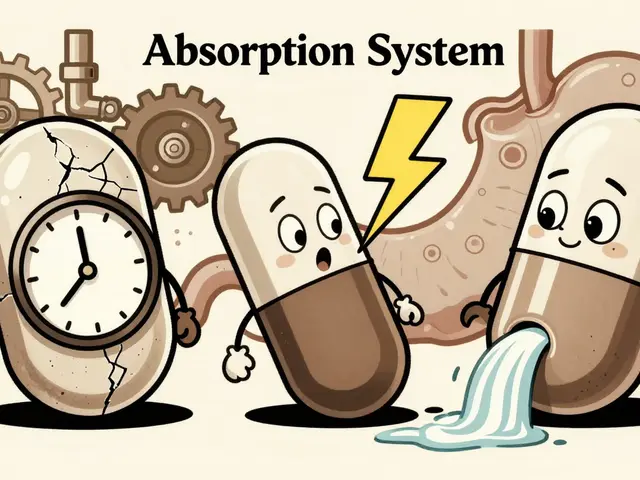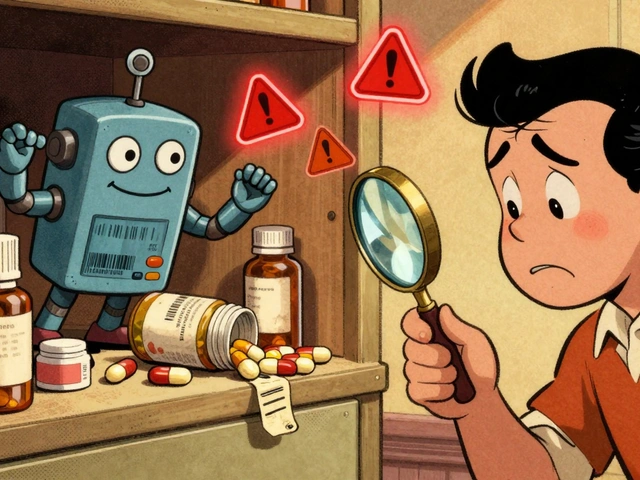Nortriptyline Side‑Effect Management Checker
Nortriptyline is a tricyclic antidepressant (TCA) prescribed for depression, chronic pain, and some sleep disorders. It works by boosting norepinephrine and serotonin levels in the brain, helping mood and pain signals stabilize. While many patients benefit, the drug often brings side effects that can feel overwhelming. This guide walks you through the most frequent issues, practical ways to tame them, and when a doctor’s call is essential.
Understanding Nortriptyline and Its Pharmacology
Nortriptyline belongs to the tricyclic antidepressant family, a class discovered in the 1950s. Its half‑life ranges from 18 to 44 hours, meaning it stays in the system for a full day after each dose. The medication is metabolized primarily by the liver enzyme CYP2D6. People who are "poor metabolizers" may feel stronger effects and a higher chance of side effects.
Typical therapeutic doses start low - often 25mg at night - and are gradually increased (titration) to 100mg or more, depending on response and tolerability. Because the drug accumulates, side effects may appear or intensify during the first few weeks.
Most Common Side Effects (and Why They Happen)
- Drowsiness - TCAs have antihistamine properties that make you feel sleepy.
- Dry mouth - Blockade of muscarinic receptors reduces saliva production.
- Weight gain - Increased appetite and slower metabolism are common.
- Constipation - Reduced GI motility due to anticholinergic effects.
- Blood pressure changes - Some patients experience orthostatic hypotension.
- Drug interactions - Nortriptyline can combine with SSRIs, MAOIs, or certain heart meds, raising serotonin syndrome risk.
Understanding the root cause helps you target the right remedy instead of resorting to vague “just take something else.”
Step‑by‑Step Strategies to Tame Each Symptom
- Drowsiness
- Take the dose before bedtime. If you need daytime alertness, discuss a split‑dose schedule with your doctor.
- Limit caffeine after 2p.m. to avoid a crash later.
- Short, 10‑minute walks or light stretching can boost circulation without overstimulating the nervous system.
- Dry Mouth
- Sip water frequently; keep a bottle at your desk.
- Chew sugar‑free gum or suck on xylitol lozenges to stimulate saliva.
- Avoid alcohol‑based mouthwashes; opt for alcohol‑free fluoride rinses.
- Weight Gain
- Track meals with a simple notebook; awareness alone often curbs mindless snacking.
- Incorporate protein‑rich snacks (Greek yogurt, boiled eggs) to stay fuller longer.
- Schedule a 30‑minute brisk walk after dinner - it counteracts the drug’s metabolic slowdown.
- Constipation
- Increase fiber: whole grains, berries, beans. Aim for 25‑30g daily.
- Drink at least 2L of water; hydration softens stool.
- Gentle daily probiotic (Lactobacillusrhamnosus) can help restore gut rhythm.
- Blood Pressure Fluctuations
- Rise slowly from sitting or lying positions; pause 30seconds before standing.
- Check your blood pressure at home twice a week during the titration phase.
- If dizziness persists, your clinician may lower the dose or add a low‑dose fludrocortisone.
- Drug Interactions
- Maintain a medication list (prescription, OTC, supplements). Share it at every appointment.
- Avoid combining with other serotonergic agents (e.g., SSRIs) unless a physician has explicitly approved a wash‑out period.
- Inform the pharmacist that you’re on nortriptyline; they can flag risky combos.

Lifestyle Adjustments That Complement Medical Management
While the tips above target symptoms directly, broader lifestyle tweaks can lessen the overall burden.
- Sleep hygiene - Keep the bedroom cool, dark, and electronics‑free. A consistent bedtime reinforces the drug’s sedating effect in a healthy way.
- Balanced diet - Prioritise lean proteins, omega‑3 rich fish, and plenty of vegetables. Nutrient‑dense meals support neurotransmitter synthesis.
- Regular exercise - Even 20minutes of moderate activity three times a week improves mood, reduces weight gain, and boosts gastrointestinal motility.
- Stress management - Practice deep‑breathing or mindfulness apps for 5minutes daily; stress can magnify side effects like dry mouth and constipation.
Monitoring: When to Call Your Doctor
Most side effects ease after 2-4weeks, but some signals demand immediate attention:
- Rapid heart rate (>120bpm) or palpitations.
- Severe dizziness leading to falls.
- Persistent nausea with vomiting, which can cause dehydration.
- Signs of serotonin syndrome - agitation, high fever, muscle rigidity.
- Any mood swing toward suicidal thoughts, especially in the first few weeks.
Keep a symptom diary; note the date, severity (1‑10 scale), and any triggers. This record speeds up clinical decisions.
Comparison: Nortriptyline vs Amitriptyline
| Attribute | Nortriptyline | Amitriptyline |
|---|---|---|
| Primary Metabolite | Active (nortriptyline itself) | Inactive (amitriptyline → nortriptyline) |
| Typical Starting Dose | 25mg nightly | 25mg nightly |
| Half‑Life | 18‑44hr | 10‑28hr (parent) + 30‑50hr ( metabolite) |
| Anticholinergic Burden | Moderate | High |
| Common Side Effects | Drowsiness, dry mouth, weight gain | Dry mouth, constipation, blurred vision |
| Preferred for | Patients needing less sedation | Severe depression with insomnia |
Both drugs share the same mechanism, but nortriptyline generally produces fewer anticholinergic symptoms, making it a better starter for many adults.
Quick Reference Checklist
- Start low and titrate slowly.
- Take the dose at night to use drowsiness to your advantage.
- Hydrate, chew sugar‑free gum, and keep a water bottle handy.
- Track food, fluid, and bowel movements daily.
- Review all meds and supplements with each prescriber.
- Log any new or worsening symptoms and call the doctor if they involve heart rate, severe dizziness, or mood changes.
Stick to this list for the first month - most troublesome side effects either improve or become predictable patterns you can manage.

Frequently Asked Questions
Can I take nortriptyline with over‑the‑counter painkillers?
Acetaminophen is generally safe, but NSAIDs (ibuprofen, naproxen) can increase the risk of stomach irritation when combined with the anticholinergic effects of nortriptyline. Always check with your pharmacist.
Why does my blood pressure drop when I stand up?
Nortriptyline can cause orthostatic hypotension by relaxing blood vessels. Rising slowly, staying hydrated, and wearing compression stockings can mitigate the drop.
Is it safe to combine nortriptyline with an SSRI?
Combining two serotonergic agents raises the chance of serotonin syndrome, a potentially life‑threatening condition. If a switch is needed, doctors typically impose a 2‑week wash‑out period.
Can lifestyle changes eliminate the need for dose adjustments?
Good sleep hygiene, steady exercise, and a balanced diet can reduce the intensity of side effects, often allowing the prescriber to keep the dose stable. However, medication metabolism varies, so some dose tweaks are still expected.
What should I do if I miss a dose?
Take the missed tablet as soon as you remember, unless it’s already close to the next scheduled dose. In that case, skip the missed one and resume the regular timing. Never double‑dose.










Yo, just chueg a bottle of water and the dry mouth disappears.
Hey man, staying hydrated is key-carry a reusable bottle, sip every 20 minutes, and mix in a little sugar‑free gum for that extra saliva boost. It’ll keep your mouth from feeling like the Sahara while you’re on nortriptyline.
First off, remember that side‑effects are often a sign your body is adjusting, not a failure of the medication.
Take the dose right before bed; you’ll turn that drowsiness into a solid night’s sleep.
Keep a water bottle on your desk and set a timer to remind yourself to sip-hydration fights dry mouth and constipation simultaneously.
Chewing sugar‑free gum or sucking on xylitol lozenges can stimulate saliva production without adding sugar.
When you notice weight gain, start a simple food log; just jotting down what you eat can curb mindless snacking.
Include protein‑rich snacks like Greek yogurt or a handful of nuts to stay fuller longer.
Pair your meals with a short walk after dinner; even 15‑minutes of brisk activity helps metabolism and digestion.
Fiber is your friend-aim for at least 25 grams daily from fruits, veggies, beans, and whole grains.
Don’t forget to drink enough water; aim for about 2 liters, which softens stool and supports overall health.
Consider a daily probiotic (Lactobacillus rhamnosus is a solid choice) to keep your gut rhythm in check.
Orthostatic dizziness? Rise slowly from sitting, pause half a minute before standing, and keep a bottle of water handy.
Monitoring your blood pressure at home twice a week can catch any drops early, and you can share those numbers with your doc.
If your doctor thinks it’s needed, a low‑dose fludrocortisone can help stabilize those dips.
Stay vigilant about drug interactions-keep a running list of prescriptions, OTC meds, and supplements, and show it at every appointment.
Avoid mixing serotonergic agents without a proper wash‑out; the risk of serotonin syndrome isn’t worth it.
Lastly, keep a symptom diary with dates, severity scores (1‑10), and any triggers; this information speeds up any needed dose adjustments.
Indeed, the systematic approach you outlined mirrors the classic titration protocol: low‑dose initiation, gradual escalation, and vigilant monitoring. By anchoring the medication schedule to nocturnal administration, one leverages the antihistaminic sedative effect constructively. Moreover, integrating behavioral strategies-such as paced hydration and fiber enrichment-addresses the anticholinergic sequelae without additional pharmacotherapy. This dual‑pronged regimen exemplifies the principle of therapeutic synergy.
Alright, if you’re mixing ibuprofen with nortriptyline, watch out for that extra gut irritation; a simple acetaminophen is safer.
Totally agree 😃. I keep a flavored water bottle at work and it actually makes me look forward to drinking. Also, a cute little minty gum helps my mouth feel less like a desert.
While the aforementioned anecdotal remedies possess a veneer of practicality, they scarcely attain the rigor demanded by a pharmacologically nuanced discourse. One must, therefore, contextualize such suggestions within an evidence‑based framework before deeming them universally applicable.
Yo folks!! Just a quick tip: set an alarm for your water breaks-helps u not forget!! 🙃 Also, try warm water + honey before bed, sooo soothing for the throat & dry mouth!!